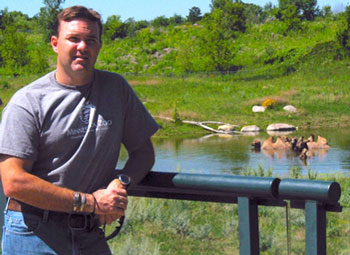Namibia’s frequent visitor
SJU graduate Muntifering helps protect black rhino
August 16, 2010
By Mike Killeen

When Brad Pitt and Angelina Jolie flew to Namibia for the birth of their daughter, Shiloh, in 2006, many Americans ran to their computers to find out where the country on the southwestern coast of Africa was.
"Brad and Angelina sort of helped put Namibia on the map, for a lot of Americans," said Saint John's University graduate Jeff Muntifering, a conservation biologist with the Minnesota Zoo in Apple Valley.
There was no need for Muntifering to pull out a map. He has spent the majority of the past eight years in Namibia helping to save black rhinos from extinction as part of the Namibian-based Save the Rhino Trust.
In 2009, the Minnesota Zoo joined forces with the Nature Conservancy and Save the Rhino Trust to protect the black rhino and the wild lands they need to survive. There are just 4,000 black rhinos left in the world after poachers killed off 96 percent of the population between 1970 and 1990, largely fueled by the black market demand for their horns. One-third of the world's remaining wild black rhino persist in Namibia, where an ambitious, innovative rhino 'custodianship' program, spearheaded by the government, aims to restore rhino populations on both public and private land.
That's where Muntifering comes in. As a scientific advisor to Save the Rhino Trust, he provides technical support to key decision-makers and skills training to communities that agree to protect the species. The community can then enter into contracts with private ecotourism companies who share their profits with them.
"It's really framed around the Zoo's mission of connecting people with nature through supporting wilderness-based conservation efforts," Muntifering said. "There are not a lot of zoos around the world that are directly supporting such conservation work outside the zoo border with their own staff.
"All the rhinos are government-owned, so any management has to go through the (Namibia) government. The communities are actively requesting to get rhinos back on their land, which is an extremely rare occurrence in Africa."
Working with multiple levels of government can be challenging, Muntifering said. The 1999 graduate of SJU with a degree in biology harkens back to his classes at the College of Saint Benedict and Saint John's University as preparing him well for his current job - being able to think critically about issues and to actively participate in discussions.
"Those are things that I think are really cultivated by a small university with small classes, professors that you can go one-on-one with, and that's what I think I really got out of a lot of the courses (at CSB and SJU)," Muntifering said.
He never imagined he would be doing this as a profession. He came to SJU from Sartell (Minn.) High School to play football for legendary coach John Gagliardi, and was interested in pursuing a career in sports medicine.
But in the spring of 1998, he took part in CSB/SJU's first semester-long study abroad trip to South Africa.
"I made a very, very strong connection with Africa," Muntifering said. "I also realized that by talking to some professors at the university (in South Africa) and some other folks, you could actually make a career out of field biology. Those two things sort of came together, and I came back - I still had a year left at Saint John's - and worked really hard to try and get as many conservation-related courses under my belt.
"Within one year I was basically able to shift my whole focus, still graduate in four years with a biology diploma and still go ahead with what I wanted to do," Muntifering said.
Muntifering recently returned to Namibia, where he joined a capture and translocation team in the field to move "at least a dozen rhino" onto new community lands that haven't had rhino in decades.
"We are looking at a much more holistic direction, I would say, over the next four or five years," Muntifering said. "The rhino will always be a major, major focus species for conservation in the region, but to sustain rhino, you really have to look at a much broader picture - one that includes the dynamics within and between the ecological, social, political and economical systems. Climate change is going to be a huge, huge issue that really hasn't hit us yet, but it something we need to be especially aware of being in the desert. All these things coming together make for a pretty complex picture."
